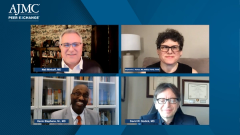
Managing Migraine Patients During the Pandemic
A discussion on how the coronavirus pandemic has affected conventional management of patients with migraine, and how to circumnavigate shortcomings.
Episodes in this series

Neil Minkoff, MD: I’d be remiss if I didn’t ask this question. Everyone’s practice has been impacted by the pandemic and by COVID-19 [coronavirus disease 2019]. What has the effect been on a migraine or headache practice? How has it been affecting the way you see and interact with patients?
Stephanie J. Nahas, MD, MSEd, FAHS, FAAN: Would you like me to start?
Neil Minkoff, MD: Please do, yes.
Stephanie J. Nahas, MD, MSEd, FAHS, FAAN: We’ve had to prioritize when and how we see patients in person. Some things you cannot do over a video visit. I don’t have needles that go through the computer screen. My patients who need injections or infusions have to come to the clinic. We are going to have to make sure that everyone is safe, and that means reducing the throughput, doing a lot of sanitizing, and having fewer people providing care in the office at that time.
We’re doing a lot of telemedicine now, which we hardly did before. It was this mother of invention that came along and made us get good at it. It’s been a long time coming. But on the whole, that has been good. We’ve learned that there is a lot that we can do with a virtual visit. A lot of taking care of migraine is just talking it out, strategizing, and prioritizing. You don’t always have to put your hands on someone or put a needle into them to get them better.
Sometimes you do, and that’s the reason our clinic prioritized staying open for those essential procedures. But for the safety of everyone, we’re shifting as much as possible into the virtual space. We have more of a hybrid model, doing a lot more routine, in-person care. But everyone can see the writing on the wall. It’s probably going to have to shift again, and it’s all a learning process. Honestly, it’s for the better. We all believe that telemedicine had tremendous potential to improve efficiency in medicine, reduce overall costs, and increase satisfaction for patients and providers alike. On the whole, there are some silver linings to see in this terrible black cloud. But there’s still a lot of work to be done to optimize it for all of us.
Neil Minkoff, MD: Dr Dodick?
David W. Dodick, MD: Yes, I don’t have a whole lot to add. We’re still seeing some patients virtually and some patients in the clinic. What virtual care has allowed is better access for patients to specialist providers. By that, I mean that I’ve seen patients from Dublin, Ireland, to Alaska to Honolulu, Hawaii. They don’t have to get on a plane. They don’t have to book airfare, ground transportation, and hotels. I’m seeing them from the comfort of their own home.
If I feel that the diagnosis is in question at all, then I will either have their primary care provider or their referring neurologist do the diagnostic tests that are necessary. In some cases, they actually have to get on a plane eventually and come see me for that diagnostic evaluation.
But for routine follow-up care, unless there has been a dramatic change in the character of the patient’s headache or a new disease that they’ve developed, virtual care has been fantastic for patients. They get the same amount of time. In fact, sometimes they get more face-to-face time. They do so from the comfort of their own home. They feel safe and protected. Getting on a plane and coming to see me from a distance is terribly disruptive. Traveling 4 hours from northern Arizona is terribly disruptive for patients. If I can accomplish the same thing virtually, then that’s what I’d like to do. I know that’s what many patients would like to do as well.
Is been great for us. The other thing that’s happened is they’ve taken down barriers. In the past, when I used to do telestroke, I used to have to be licensed in every state in which I consulted with patient and delivered care. If I was seeing a patient in the emergency department in New Hampshire, I’d have to be licensed in New Hampshire. To do that is a 4- to 6-month process.
With COVID-19, I don’t have to be licensed in New Hampshire to see a patient in New Hampshire, or any state in the country. Reimbursement for those visits to my institution is now on par with a face-to-face visit. That’s likely to change, but right now, that’s what allows me to see patients from far-flung areas around the country. It’s been great.
Neil Minkoff, MD: With that, this has been a very rich discussion. I want to thank all of you. This has been enlightening and a very informative panel discussion. Before we wrap up, I’d like to get parting thoughts from each of you. Dr Nahas?
Stephanie J. Nahas, MD, MSEd, FAHS, FAAN: I’m hopeful that the whole world, not just clinicians and the people who live with migraine every day, will start to see it for what it is. It’s too invisible a disease right now. Much of our job is raising awareness about its seriousness. Now that there’s so much more that we can do for it, it’s 1 of the most gratifying things you can do in medicine. The reason that I’m in this field is even when I’m having the worst day, all I have to do is reflect on some of the patients who’ve expressed their gratitude, and I know that I’ve helped. That’s what keeps me going.
Neil Minkoff, MD: That’s great. Thank you. Dr Stephens?
Kevin Stephens Sr., MD: Thank you very much for this opportunity to share with you. The main thing for me is outcome. That’s what it’s all about. It’s quality of life. Quality of life is something we all need to have—healthy, vibrant lives, families, and careers. That is interrupted by pain and disability. From my perspective, we look at utilization like claims and those types of things to see how healthy your life is. Our goal is to have a healthy life
And we do have to look at cost. Because health care prices are rising exponentially, we have to really be careful about the cost. But the ultimate ends are the needs of the patient. Thank you again. I hope we can continue to progress in treatment, diagnosis, availability, and modalities so we can get this disease under control in our country and the world.
Neil Minkoff, MD: Dr Dodick?
David W. Dodick, MD: I couldn’t agree more. I work at an institution whose motto is that the needs of the patient come first. The needs of the patient are the only interests to be considered. To Dr Stephens’ point, at the end of the day, we’re trying to improve the quality of lives of the patients we see.
We’re dealing with a disease that, among people below the age of 50 years old, is the most disabling on the planet. According to the Global Burden of Disease study that was released in November, stroke, Alzheimer disease, and migraine are the 3 most disabling neurological conditions in the United States from 1990 to 2017. That means clinicians of all types need to take this disease more seriously.
Dr Nahas and I have spent the better parts of our careers trying to beat down the stigma associated with this disease. We need sympathy for these patients. There’s so much we can do for them. The patients Dr Nahas and I see are at this end of the spectrum. They’re the most severely affected patients in the country, yet I would argue—and I’m sure Dr Nahas would agree—that we can improve the lives of the vast majority of patients we see. That includes the most severely affected.
We need sympathy and understanding for these patients. If you feel like you’re not in a position to manage them or you’re over your head, then just refer them. But we need to take this patient population more seriously. Our emphasis today was on acute and preventive treatment. When a clinician is approaching a patient with migraine, we need to be thinking in that way. We need to consider acute and preventive components. That goes not just for medications, but lifestyle, diet, exercise, and everything else. We need to think about a disease-management model. How do we manage this as the complex disease that it is in the most comprehensive way?
Neil Minkoff, MD: That was a great way for us to wrap this up. I want to thank all of you for participating. To the people who are the viewing audience, I’m sure I speak on behalf of our panelists when I say that we hope that you found this AJMC® panel discussion to be useful, helpful, and informative. Thank you all.
David W. Dodick, MD: Thank you.
Kevin Stephens Sr., MD: Thank you.
Stephanie J. Nahas, MD, MSEd, FAHS, FAAN: Thank you very much.
Newsletter
Stay ahead of policy, cost, and value—subscribe to AJMC for expert insights at the intersection of clinical care and health economics.




























































